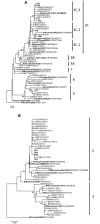Long-Term Shedding of Influenza Virus, Parainfluenza Virus, Respiratory Syncytial Virus and Nosocomial Epidemiology in Patients with Hematological Disorders
- PMID: 26866481
- PMCID: PMC4750950
- DOI: 10.1371/journal.pone.0148258
Long-Term Shedding of Influenza Virus, Parainfluenza Virus, Respiratory Syncytial Virus and Nosocomial Epidemiology in Patients with Hematological Disorders
Abstract
Respiratory viruses are a cause of upper respiratory tract infections (URTI), but can be associated with severe lower respiratory tract infections (LRTI) in immunocompromised patients. The objective of this study was to investigate the genetic variability of influenza virus, parainfluenza virus and respiratory syncytial virus (RSV) and the duration of viral shedding in hematological patients. Nasopharyngeal swabs from hematological patients were screened for influenza, parainfluenza and RSV on admission as well as on development of respiratory symptoms. Consecutive swabs were collected until viral clearance. Out of 672 tested patients, a total of 111 patients (17%) were infected with one of the investigated viral agents: 40 with influenza, 13 with parainfluenza and 64 with RSV; six patients had influenza/RSV or parainfluenza/RSV co-infections. The majority of infected patients (n = 75/111) underwent stem cell transplantation (42 autologous, 48 allogeneic, 15 autologous and allogeneic). LRTI was observed in 48 patients, of whom 15 patients developed severe LRTI, and 13 patients with respiratory tract infection died. Phylogenetic analysis revealed a variety of influenza A(H1N1)pdm09, A(H3N2), influenza B, parainfluenza 3 and RSV A, B viruses. RSV A was detected in 54 patients, RSV B in ten patients. The newly emerging RSV A genotype ON1 predominated in the study cohort and was found in 48 (75%) of 64 RSV-infected patients. Furthermore, two distinct clusters were detected for RSV A genotype ON1, identical RSV G gene sequences in these patients are consistent with nosocomial transmission. Long-term viral shedding for more than 30 days was significantly associated with prior allogeneic transplantation (p = 0.01) and was most pronounced in patients with RSV infection (n = 16) with a median duration of viral shedding for 80 days (range 35-334 days). Long-term shedding of respiratory viruses might be a catalyzer of nosocomial transmission and must be considered for efficient infection control in immunocompromised patients.
Conflict of interest statement
Figures





Similar articles
-
Respiratory syncytial virus A in haematological patients with prolonged shedding: Premature stop codons and deletion of the genotype ON1 72-nucleotide-duplication in the attachment G gene.J Clin Virol. 2018 Jan;98:10-17. doi: 10.1016/j.jcv.2017.11.003. Epub 2017 Nov 13. J Clin Virol. 2018. PMID: 29175230
-
The clinical and phylogenetic investigation for a nosocomial outbreak of respiratory syncytial virus infection in an adult hemato-oncology unit.J Med Virol. 2017 Aug;89(8):1364-1372. doi: 10.1002/jmv.24800. Epub 2017 Mar 22. J Med Virol. 2017. PMID: 28240370
-
[Lower respiratory tract infections with influenza and respiratory syncytial viruses in hospitalized elderly patients during the 2005-2006 winter season].Presse Med. 2009 Jun;38(6):893-903. doi: 10.1016/j.lpm.2008.09.024. Epub 2008 Dec 18. Presse Med. 2009. PMID: 19097850 French.
-
Respiratory syncytial virus and parainfluenza virus infections in the immunocompromised host.Semin Respir Infect. 1995 Dec;10(4):224-31. Semin Respir Infect. 1995. PMID: 8668850 Review.
-
Nosocomial respiratory syncytial virus infections in children's wards.Diagn Microbiol Infect Dis. 2000 Aug;37(4):237-46. doi: 10.1016/s0732-8893(00)00154-1. Diagn Microbiol Infect Dis. 2000. PMID: 10974574 Review.
Cited by
-
Use of Whole-Genome Sequencing in the Investigation of a Nosocomial Influenza Virus Outbreak.J Infect Dis. 2018 Sep 22;218(9):1485-1489. doi: 10.1093/infdis/jiy335. J Infect Dis. 2018. PMID: 29873767 Free PMC article.
-
Giant intracardiac thrombosis in an infant with leukaemia and prolonged COVID-19 viral RNA shedding: a case report.Thromb J. 2021 May 12;19(1):31. doi: 10.1186/s12959-021-00285-8. Thromb J. 2021. PMID: 33980250 Free PMC article.
-
Prolonged SARS-CoV-2 Infection in Patients with Lymphoid Malignancies.Cancer Discov. 2022 Jan;12(1):62-73. doi: 10.1158/2159-8290.CD-21-1033. Epub 2021 Nov 9. Cancer Discov. 2022. PMID: 34753749 Free PMC article.
-
Modeling household dynamics on Respiratory Syncytial Virus (RSV).PLoS One. 2019 Jul 9;14(7):e0219323. doi: 10.1371/journal.pone.0219323. eCollection 2019. PLoS One. 2019. PMID: 31287832 Free PMC article.
-
Hemato- Oncology Care in COVID-19 Pandemic: Crisis within a Crisis.Asian Pac J Cancer Prev. 2020 May 1;21(5):1173-1175. doi: 10.31557/APJCP.2020.21.5.1173. Asian Pac J Cancer Prev. 2020. PMID: 32458618 Free PMC article. No abstract available.
References
-
- Avetisyan G, Mattsson J, Sparrelid E, Ljungman P. Respiratory syncytial virus infection in recipients of allogeneic stem-cell transplantation: a retrospective study of the incidence, clinical features, and outcome. Transplantation 2009;88: 1222–1226. - PubMed
-
- Chemaly RF, Ghosh S, Bodey GP, Rohatgi N, Safdar A, Keating MJ, et al. Respiratory viral infections in adults with hematologic malignancies and human stem cell transplantation recipients: a retrospective study at a major cancer center. Medicine (Baltimore) 2006;85: 278–287. - PubMed
-
- Falsey AR, Hennessey PA, Formica MA, Cox C, Walsh EE. Respiratory syncytial virus infection in elderly and high-risk adults. N Engl J Med 2005;352: 1749–1759. - PubMed
-
- Renaud C, Xie H, Seo S, Kuypers J, Cent A, Corey L, et al. Mortality rates of human metapneumovirus and respiratory syncytial virus lower respiratory tract infections in hematopoietic cell transplantation recipients. Biol Blood Marrow Transplant 2013;19: 1220–1226. 10.1016/j.bbmt.2013.05.005 - DOI - PMC - PubMed
Publication types
MeSH terms
Grants and funding
LinkOut - more resources
Full Text Sources
Other Literature Sources
Medical

